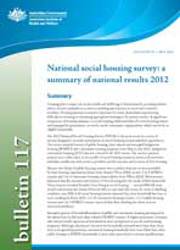Summary
Housing plays a major role in the health and wellbeing of Australians by providing shelter, safety, security and privacy, as well as enabling participation in social and economic activities. Housing assistance remains important for many Australians experiencing difficulty in securing or sustaining appropriate housing in the private market. A significant component of housing assistance is social housing, which includes all rental housing owned and managed by government, or not-for profit community organisations, which can be let to eligible households.
The 2012 National Social Housing Survey (NSHS) is the most recent in a series of surveys designed to provide information on social housing tenants and their experiences. The survey sampled tenants of public housing, state owned and managed Indigenous housing (SOMIH) and community housing programs from May to July 2012. Indigenous community housing (ICH) was not covered in the 2012 survey. The survey's primary purpose is to collect data on the profile of social housing tenants in states and territories and their satisfaction with services provided and the amenity and location of their housing.
Almost two-thirds of public housing tenants were satisfied with the services provided by their housing organisation (down from almost 73% in 2010), as were 3 in 5 SOMIH tenants and 3 in 4 community housing tenants (down from 79% in 2010). Most tenants indicated that the amenity and location of their housing met the needs of their household. These tenants recorded 'benefits' from living in social housing - around 80% felt more settled and around two-thirds felt better able to cope with life events. In terms of dwelling condition, over 90% of all social housing tenants reported that their household has four or more working facilities, while 1 in 10 community housing tenants, 1 in 5 public housing tenants and 1 in 3 SOMIH tenants reported that their dwelling has three or more structural problems.
Around a quarter of household members of public and community housing participated in the labour force as did more than a third of SOMIH tenants. A higher proportion of tenants who had previously experienced homelessness were unemployed across all social housing programs. Although educational outcomes for households surveyed were lower than those seen in the general population, community housing households were more likely than either public housing or SOMIH households to have either post-school or tertiary qualifications.
More than half of public and community housing households consisted of a single person living alone, as did a quarter of SOMIH households. Overall, public housing and SOMIH tenants had lived in their current home longer than community housing tenants, with twice as many community housing respondents having moved into their current home in the last 2 years. Around 1 in 10 public housing and SOMIH tenants reported that they had experienced homelessness at least once in the past 5 years, as had 1 in 5 community housing tenants. Across all social housing programs, tenants who had experienced homelessness reported they resided in short-term or emergency accommodation, while more than 1 in 4 had slept rough or in non-conventional accommodation.
The most common community and health services accessed by social housing tenants were health, medical services and mental health services, but these were among the least likely to be accessed by tenants with assistance from their housing providers. Of those tenants who did seek their housing provider's assistance in accessing services, residential care and supported accommodation were most commonly accessed.



